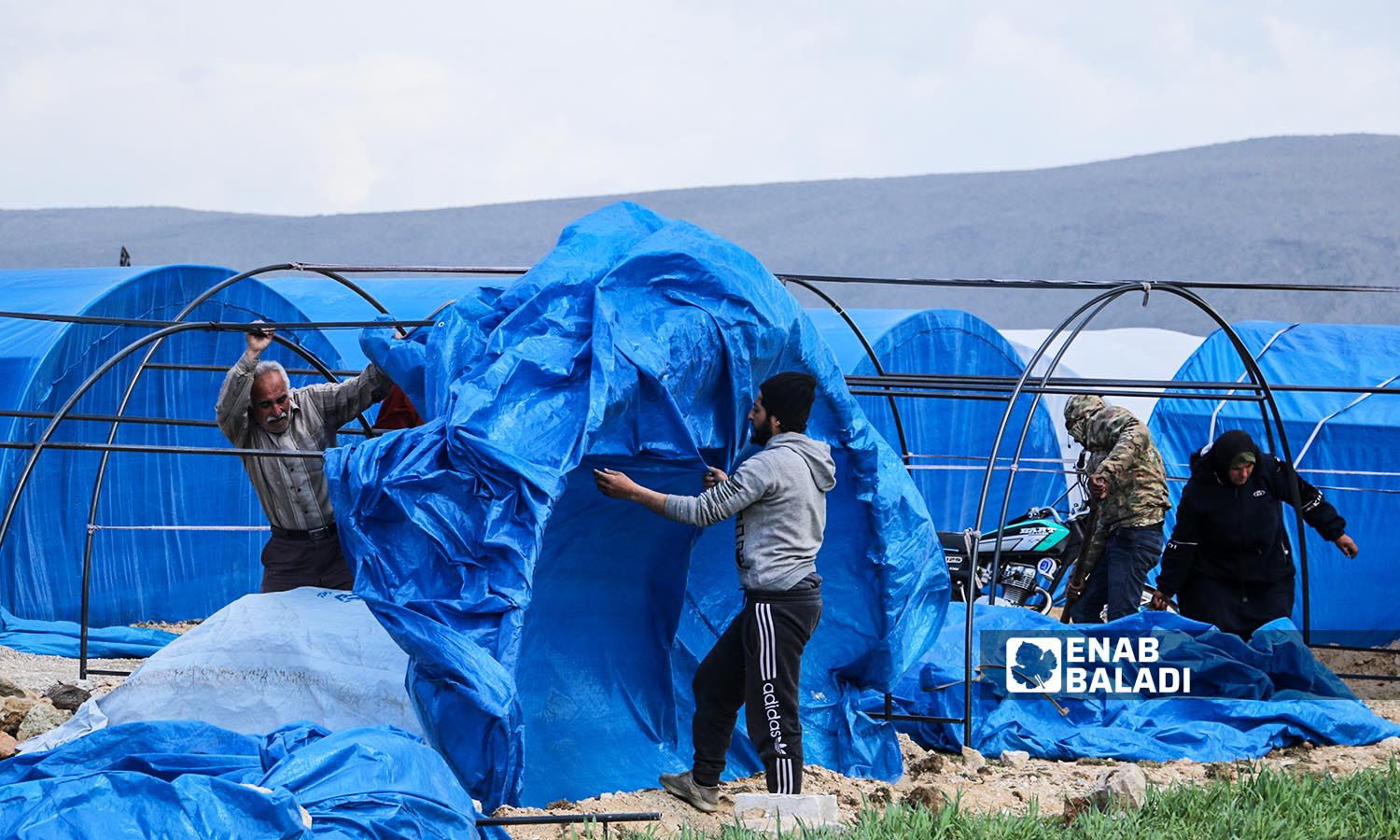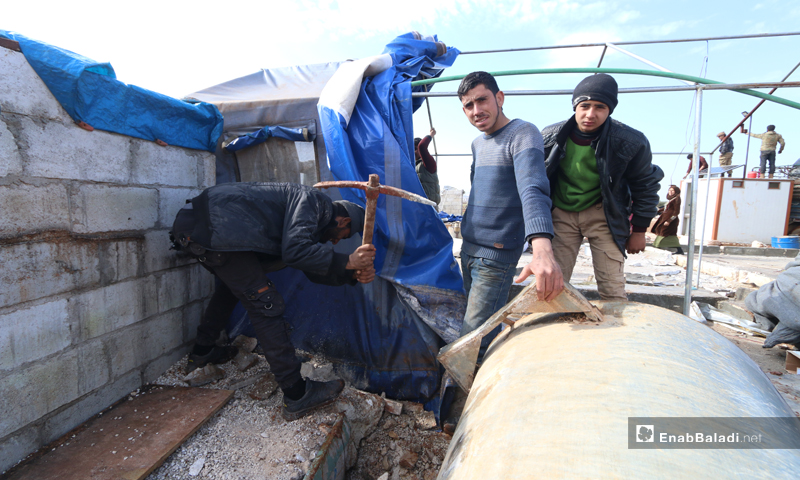



Enab Baladi – Hassan Ibrahim
“We are sitting on the street, needing housing and renovating houses. We don’t want food; the home pantry is enough for me and my family for six months,” Farah al-Din Othman, of the northern town of Jindires, summed up his demands after he ended up in a tent with his family in one of the town’s streets following the Feb.6 massive earthquake.
Cracks and fissures affected Othman’s house, as is the case of thousands of families who sought refuge in shelters, camps, and cars following the earthquake that resulted in the collapse of more than 550 buildings, and more than 1,570 were partially damaged, and thousands of buildings and houses in northwestern Syria were cracked.
The demands for restoration and rebuilding of what was destroyed by the earthquake are repeated in more than 60 towns and villages affected by the earthquake in northwestern regions of Syria, with the presence of the Syrian Salvation Government (SSG) in Idlib region and part of the western countryside of Aleppo, and the Syrian Interim Government (SIG) in the northern and eastern countryside of Aleppo, in addition to relief and humanitarian organizations and associations.
The rescue Syria Civil Defense (SCD) agency estimated the number of families displaced by the earthquake at about 40,000.
In a temporary solution, Othman took refuge with his family in the house of his relatives, which was not damaged, and stayed with them for a week, after which he erected a tent in the street of the neighborhood in which he resides, waiting for any activity to restore and rebuild the damaged buildings.
On February 6, an earthquake struck southern Turkey and four Syrian governorates, resulting in 2,274 deaths and 12,400 injuries in northwestern Syria, according to the statistics of the Syria Civil Defense, in addition to the statistics of the people in the affected points, with the presence of thousands of families looking for tents, and recording cases of more than one family residing in the same tent.
Nawras Jahwani lives with his family consisting of 12 people, in a tent after the collapse of their house in the town of Harem in the northwestern countryside of Idlib, as he complained of the lack of means of life in it, as is the case of his neighbor in a neighboring tent, Abdul Jabbar al-Sawadi, who lives with 17 members of his family in the same tent, and they receive one lunch meal and two bundles of bread daily.
Jahwani told Enab Baladi that the camp in which he lives with dozens of families is not even fit to be a temporary solution, calling on the concerned authorities to restore and rebuild homes and find permanent solutions.
On March 6, dozens of tents were damaged by high-speed winds in northwestern Syria.
The Syria Response Coordinators Group working in northern Syria documented the damage to more than 28 camps for the displaced in various regions and the uprooting and destruction of 58 tents.
The team stated that the newly established camps accounted for 70% of the recorded damages, which were distributed among regions, with 13 camps in Idlib and 15 camps in the countryside of Aleppo city.

Displaced people trying to repair their tents after they were damaged by an air storm in Jisr al-Shughour region, west of Idlib – March 6, 2023 (Enab Baladi/Mohammad Nasan Dabel)
More than a month after the earthquake, the issue of restoring the damaged buildings and rebuilding the destroyed ones remains unclear amid ongoing examination and evaluation of the damaged buildings by engineering committees and volunteer teams.
The director of public relations in the Salvation Government, Jamal al-Shahoud, told Enab Baladi that with the end of the first phase of rescuing the trapped and removing the rubble, work has begun to enumerate the partially and completely damaged buildings, and the government has reached 60% of the damage statistics.
Al-Shahoud explained that the work to repair the damaged buildings would take place within a “joint local and governmental plan,” in addition to directing the organizations and providing them with sufficient and accurate information about the damage and providing the necessary needs for them by the Ministry of Development and Humanitarian Affairs in the Salvation Government.
Al-Shahoud stated that the Salvation Government directed the Ministry of Development to focus on securing housing in the next phase for those affected by the earthquake within the criteria of the most affected and most in need.
Mohammad Nawaf al-Sayyed Ali, head of the local council in the town of Harem, told Enab Baladi that efforts are focused on the second phase of response to open the roads and remove the rubble, and then start the phase of maintaining public utilities, including roads, water, and sanitation networks.
Al-Sayyed told Enab Baladi that the town witnessed the complete collapse of 430 to 450 apartments, and 200 to 250 apartments were badly damaged, and 300 to 350 apartments were cracked.
The deputy head of the local council in Jindires, Yazan al-Nasser, told Enab Baladi that the response is still in the stage of removing the rubble, without any promises or projects made by any party, whether organizations or government agencies for restoration or reconstruction.
Al-Nasser added that the current urgent needs are to rehabilitate the infrastructure and prepare roads, and water and sewage networks, because of their impact on people’s health, especially with the rising temperatures in the coming months.
On March 5, maintenance work for the sewage network in al-Tilal neighborhood in Jindires began by the local city council in cooperation with the Syria Civil Defense agency.
The Interim Government formed a central committee on March 6 to survey and assess the damage to buildings and engineering facilities, both private and public, resulting from the earthquake in the areas under its control.
The committee consists of ten people and undertakes eight tasks, most notably preparing questionnaires for assessing technical and engineering damages and submitting a final report explaining the technical reasons for the non-resistance of buildings and facilities damaged in the earthquake.
As well as submitting a draft estimated budget for the cost of public and private damages and submitting recommendations and proposals for the post-earthquake phase.
The committee shall issue the instructions governing its work, seek the assistance of whomever it deems appropriate to accomplish its tasks and submit its report to the Minister of Local Administration upon completion of its work within a maximum period of 180 days.
The expenses resulting from the decision are also disbursed in accordance with the financial system of the Interim Government.
Hours after the earthquake disaster occurred, the union of free engineers in the countryside of Aleppo formed a committee cell to evaluate and detect buildings damaged by the earthquake. It reached approximately 22 engineering committees in coordination with councils and some local organizations for emergency response.
The committees work within a well-studied engineering plan according to three classifications for each damaged house.
The first of which is if the house is habitable or partially damaged, which requires evacuation until restoration, or is severely damaged, which requires re-evaluation by the Public Safety committee to submit a final report on the technical condition of the building, and then make the decision to repair or demolish.
Organizations, associations, and activists launched campaigns to support those affected by the earthquake in northern Syria, most of which were relief and in-kind materials, and a few were directed towards restoration or building communities and housing projects.
A few days after the earthquake, the Molham Volunteering Team launched the “We Can Fund” campaign to rebuild what was destroyed by the earthquake in northern Syria.
The campaign aims to raise $20 million as a first stage for the reconstruction of 4,000 homes at the cost of $5,000 per house.
The campaign relies entirely on donations from Syrians inside and outside the country, according to the statement of the team, which asked all Syrian organizations to join and contribute to supporting the fund to secure the required amount for reconstruction, and it was estimated by the concerned institutions at $100 million. The sum of $20 million will be collected in the first phase.
The amount received as of March 6 reached approximately $12.2 million, which means that the number of insured homes so far has reached about 2,448, and the campaign continues despite the cessation of its live broadcast.
Faisal al-Aswad, director of the response campaigns department in the Molham Volunteering Team, told Enab Baladi that the buildings would be built on new land, and the team is currently conducting a search process on land next to the affected cities so that the new houses are around the city and near its center, pointing out that the lands are communal.
Al-Aswad said that the planning process for the apartments has ended, and in the event of reliance on land, the team will start with the plans of the general site, after which a tender will be launched and implemented by undertaking, follow-up, and monitoring through the shelter section of the team.
For its part, the Free Syria Chamber of Commerce and Industry, operating in Idlib, launched a campaign titled “Khair al-Tijarah” (Adapted from a prophetic hadith “Whoever does business with Allah, profits.”) directed at all merchants and industrialists inside and outside Syria.
Its goal is to build apartments for the affected and afflicted, in cooperation with the Emergency Response Committee set up by the Salvation Government, to ensure that the money is put in the right place, according to a video recording published by the chamber.
if you think the article contain wrong information or you have additional details Send Correction